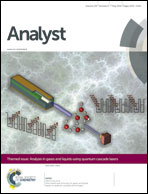Head group-functionalized poly(ethyleneglycol)–lipid (PEG–lipid) surface modification for highly selective analyte extractions on capillary-channeled polymer (C-CP) fibers†
Abstract
Polypropylene (PP) capillary-channeled polymer (C-CP) fibers were modified by adsorption of a head group-functionalized lipid to generate analyte–specific surfaces for application as a stationary phase in high performance liquid chromatography (HPLC) or solid phase extraction (SPE). The aliphatic moiety of the lipid adsorbs strongly to the hydrophobic PP surface, with the hydrophilic active head groups orienting themselves toward the more polar mobile phase, thus allowing for interactions with the desired solutes. Initial proof-of-concept was achieved by adsorbing a biotin–poly(ethylene glycol)–functionalized lipid to the surface of the PP C-CP fibers. Surface modification and uniformity was evaluated by binding streptavidin labeled with Texas Red (SAv-TR) to the biotin moiety. Isolation of SAv-TR from a mixture in neat buffer and in cleared lysate demonstrated the capability of the modified fibers to extract an analyte of interest from a complex viscous mixture. It is believed that this surface modification approach is generally applicable to a diversity of selective protein immobilization applications, including clinical diagnostics and preparative scale HPLC on C-CP fibers as well as to other hydrophobic supports.


 Please wait while we load your content...
Please wait while we load your content...